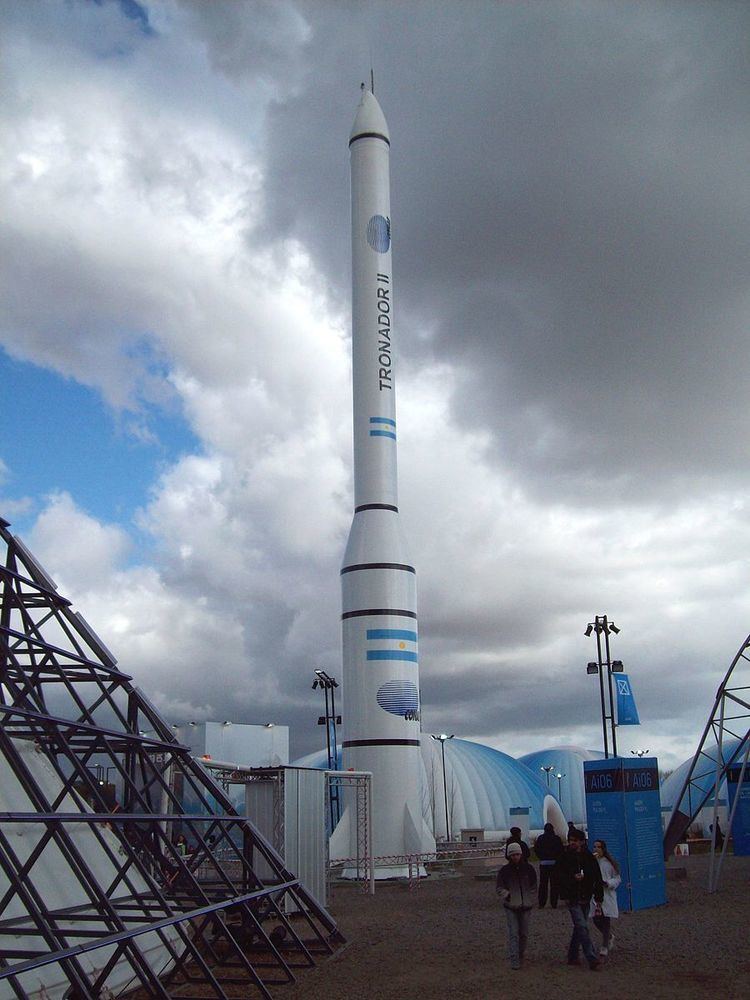Height 28 m (~92 ft) | Diameter 2.5 m | |
 | ||
Mass 67000 kg (including propellant) | ||
Tronador, also known as Thunderer, is a series of Argentine rockets, including the Tronador I and Tronador II vehicles, to develop a liquid-propellant rocket expendable launch system called ISCUL (Inyector Satelital de Cargas Utiles Ligeras, Light Payloads Satellite Launcher).
Contents
- Tronador I
- Tronador I T1
- Characteristics
- Tronador Ib T2
- VS 30
- Tronador II
- Other proposals
- T4000
- VEx
- Tronador III
- References
The Tronador I is an unguided liquid-fueled rocket used for sub-orbital spaceflight test flights. Its development led to the larger VEx test rocket that will test the technologies needed for the Tronador II, which has a guidance system and would be capable of reaching low Earth orbit.
Tronador I
The Tronador I is an unguided liquid-fueled rocket used for sub-orbital spaceflight test flights.
Tronador I (T1)
The Tronador I (T1) vehicle was flown successfully on June 6, 2007 from Puerto Belgrano Naval Base near Bahía Blanca, in the south east of the Buenos Aires Province. This was the first flight of a technology demonstrator vehicle for the program.
Characteristics
Tronador Ib (T2)
The Tronador Ib (T2) vehicle was flown successfully on August 5, 2008 from Puerto Belgrano Naval Base. This was the second technology demonstrator vehicle flown for the program.
Characteristics
VS-30
This was the first cooperative test flight between Comisión Nacional de Actividades Espaciales and Brazilian Space Agency; it was successfully flown in December 2007 (Operacion Angicos). The payload built by CONAE carried several experiments to validate subsystems for the program such as: IMU (Inertial Measurements Unit, that used IFOG's), GPS receptor (for navigation), all integrated into the on-board computer, and an attitude control system via cold-gas thrusters. The payload unit completed a suborbital flight carried by an AEB-built VS-30 solid-propellant rocket booster, and was then recovered from the sea after landing with parachutes.
Characteristics
Tronador II
The maiden Tronador II orbital launch is expected to fly in 2019, from Puerto Belgrano Naval Base.
Characteristics
As of June 2016, the proposed Tronador II configuration is:
Other proposals
The initial proposal was for a 3-stage rocket. In early 2015, an evolved configuration was presented at the 52nd Committee on Peaceful Uses of Ultra-Terrestrial Space meeting and at the Punta Indio test launch pad.
T4000
The T4000 (Tronador T4000 pathfinder rocket) test rocket is related to the project, as it is the basis of the 3rd stage of the Tronador II. Specifically, it was intended to house the attitude control system (“Thrust Vector Control” - TVS). The first launch attempt in 2011 failed.
VEx
The current strategy is to fly separately several prototype subsystems, called "VEx", before they are incorporated in the Tronador II rocket:
VEx-1A
In March 2014 a prototype named VEx-1A failed during launch from Pipinas, Punta Indio Partido, It had only one stage, 2.8 tonnes, 4t engine, 60 seconds mission, expected apogee of 2 km. VEx-1A first launch attempt was postponed in December 2013 due to ground support equipment fail. The second attempt failed on February 26, 2014. It was discovered that the failure was caused by interferences between the launch pad and the rocket, which prevented the vehicle from elevating more than 2m off the ground. The engine control mechanism shut off the fuel valve, preventing an explosion, and the rocket fell down next to the pad.
VEx-1B
First flight of the vehicle, launched on 15 August 2014 from Pipinas, Punta Indio Partido. It successfully tested propulsion, control, and navigation subsystems. 2,200 m apogee, 27 seconds flight time. It landed in the sea assisted by the recovery parachutes. Once the vehicle is recovered it will be examined to determine whether further VEx-1 test rockets are required or VEx-2 can be implemented.
VEx-5A
VEx-5A was a single stage rocket. The rocket engine are capable to produce 30t of thrust. The rocket was 17.5 meters long and 1.5 meters diameter, with a total launch weight (including fuel) of 8100 kg. The rocket was completed in mid 2015. Was scheduled to launch in October 2015, but eventually canceled because of minor issues. The test flight are projected for possibly October/November/December 2016 launch from Pipinas, Punta Indio Partido.
VEx-5B
Test flight - single stage 30t thrust engine rocket - projected for a launch 2017 from Pipinas, Punta Indio Partido.
VEx-5C
Test flight - two stage test rocket. First stage 30t thrust engine, second stage VEx-1 engine - projected for a 2019 launch from Puerto Belgrano Naval Base.
Tronador III
The proposed Tronador III would have the same diameter as Tronador II, but with a longer height (34m total). The fueled rocket would weight 89t, and be capable of delivering a 1 tonne of payload into polar orbit.
